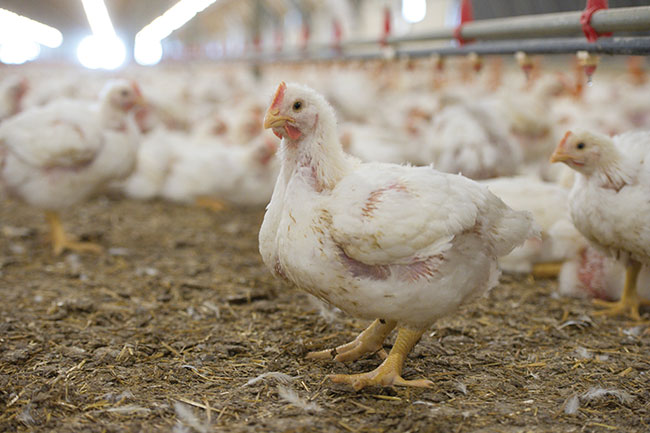
Broiler antibiotics update
By Treena Hein
Features BroilersCanada's chicken industry has been reducing its use of antibiotics for several years. Here's an update on what further progress has been made recently.
 CFC announced in early 2023 that it will not regulate the ban of preventive use of category III antibiotics.
PHOTO CREDIT: Poultry Industry Council
CFC announced in early 2023 that it will not regulate the ban of preventive use of category III antibiotics.
PHOTO CREDIT: Poultry Industry Council Over the past nine years, Canadian broiler producers have stopped using category I and II antibiotics for disease prevention and health promotion in their flocks. The Chicken Farmers of Canada Responsible (AMU) Antimicrobial Use Strategy has also been successful in ensuring only antibiotics approved by Health Canada are used by broiler producers and that antimicrobial resistance in targeted bacteria has been reduced.
By the end of 2020, preventative use of category III antibiotics (there’s just one of them used right now in Canada, Bacitracin) was mandated to end, but in September that year, CFC reassessed the timeframe. In short, stopping the preventative use of Bacitracin at that point would have resulted in serious health issues for birds, impacting bird welfare and requiring additional antimicrobial interventions.
Since then, working with industry stakeholders, CFC has moved to a non-regulatory approach for the preventive use of Category III antimicrobials. This involves focussing on education and working with supply chain partners to reduce Category III and antibiotics of importance to human health.
A reminder that the use of medically important antibiotics in the farming of livestock is a serious concern because resistance to these antibiotics means fewer critical tools in human health care to treat infections. In addition, specific attention is still being put on reducing the preventive use of Bacitracin.

Dr. Babak Sanei is national business and technical manager for poultry and medicated feed additives
at Zoetis.
PHOTO CREDIT: Zoetis
CFC’s current approach is a wise one, according to Dr. Babak Sanei, national business and technical manager for poultry and medicated feed additives at Zoetis.
“CFC announced in early 2023 that they will not regulate the ban of preventive use of category III anymore, and instead its efforts will be to help the industry towards further reduction practices,” he says. “This decision was very promising news, in my opinion, because our industry at large scale was not ready for a sudden preventive ban on category III. This [new CFC approach] will allow more time and better transition towards reduction of this category rather than an abrupt approach with unknown costly consequences.”
Sanei stresses that it’s important for the industry to accept geographical differences, density of flocks in different regions, the extent of wheat inclusion in diets in various parts of the country and allow veterinary discretion to use Bacitracin when it is needed rather than a complete ban for this category.
“There has been progress in developing new products and this momentum will continue,” he says. “However, the approach should be a collective strategy and allow flexibility to use cat III when it is needed.”
Strategy and results
Steve Leech, CFC Director of Food Safety and Animal Health, explains that the aim of the current overall strategy is to ensure protection of the health and welfare of Canadian broiler flocks while delivering “a sustainable means of meeting consumer and government expectations for using antibiotics in a responsible manner.”
The CFC strategy works collaboratively with Health Canada’s regulatory initiatives which include requiring veterinary oversight of medically important antibiotics (no over-the-counter sales), removing growth promotion claims for antibiotics, and requiring pharmaceutical companies to report annual sales of medically important products.
The success of CFC’s Strategy is being monitored and reported through the efforts of two entities: the Canadian Integrated Program for Antimicrobial Resistance Surveillance (CIPARS) and Public Health Agency of Canada’s ‘Canadian Antimicrobial Resistance Surveillance System.’
At this point, reports indicate that at least 60 per cent of total antibiotics volume applied to Canadian broiler flocks are non-medically important (they are instead Category IV antibiotics and chemical coccidiostats). Surveillance also indicates that at least 40 per cent of Canadian broiler flocks are now being produced without medically important Category I, II or III antibiotics.
“This is a significant achievement and demonstrates the success of working toward with supply chain members to implement new production practices, vaccine strategies and use of feed and water additives,” says Leech.
In addition, he is very pleased to share that “all antimicrobial use indicators (mg/PCU, mg/kg animal biomass, DDDvetCA) tracked by CIPARS decreased by 18-20 per cent in 2021 compared to 2019.”
CIPARS has also observed reductions in antimicrobial resistance (AMR) in targeted bacteria. During the six-year period from 2013 to 2019, AMR declined across most antibiotics and classes of antibiotics, while AMR of bacteria isolated from chickens declined by between six and 38 per cent.
What’s ahead
Moving forward, CFC’s focus with antibiotics will be working with broiler farmers, veterinarians and others to examine further category III reduction.
In terms of alternative products, while not many have become available recently, Sanei notes that there are some now registered in Canada for treating necrotic enteritis that, even though they are not as effective as Bacitracin, are being used in a segment of the broiler industry producing chicken destined for specific restaurant chains.
Leech adds that a key part of CFC’s Responsible AMU Strategy is engagement with the federal government to improve product access and labelling options in Canada.
“Ensuing that Canadian farmers have equal access to products as international markets is important to meeting the combined objectives of industry and the provincial and federal governments,” he says. “Of priority, industry wants the ability to use veterinary health products in feed, and have access to feed and water products (e.g., probiotics, organic acids) labelled with pathogen reduction claims.”
In addition, the federal government just released the Pan Canadian Action Plan on AMR. Leech says CFC’s Strategy works in conjunction with this plan and CFC will be engaged with the federal government as they look towards implementation.
“CFC will engage with national commodity organizations through Animal Health Canada to implement the agricultural initiatives of the plan.”
Print this page